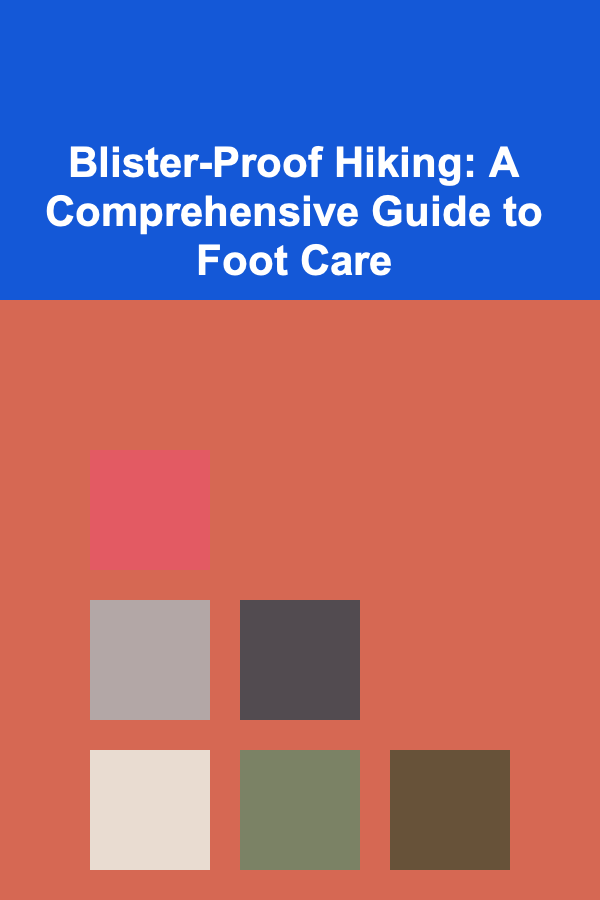
Blister-Proof Hiking: A Comprehensive Guide to Foot Care
ebook include PDF & Audio bundle (Micro Guide)
$12.99$9.99
Limited Time Offer! Order within the next:

Hiking, an activity celebrated for its breathtaking views, physical challenges, and connection with nature, can quickly turn into a miserable experience if your feet aren't properly cared for. Blisters, those small but intensely painful fluid-filled pockets, are the bane of many hikers' existence. They can derail even the most meticulously planned adventures. This comprehensive guide provides an in-depth exploration of blister prevention, treatment, and broader foot care strategies to ensure your hiking experiences remain enjoyable and blister-free.
Understanding Blisters: The Enemy Within
Before diving into solutions, it's crucial to understand what blisters are and how they form. A blister is essentially a pocket of fluid that forms between the epidermis (outer layer of skin) and the dermis (the layer beneath). This separation is usually caused by friction, pressure, heat, or a combination thereof. In hiking, the repetitive rubbing of socks and boots against the skin, especially when compounded by sweat and uneven terrain, creates the ideal breeding ground for blisters.
Here's a breakdown of the key factors contributing to blister formation:
- Friction: This is the primary culprit. Repetitive rubbing weakens the bonds between skin layers, leading to separation and fluid accumulation.
- Moisture: Sweat increases friction and softens the skin, making it more susceptible to damage. Wet socks are a blister's best friend.
- Heat: Elevated temperatures can exacerbate sweating and further weaken the skin's integrity.
- Pressure: Tight-fitting boots or areas where the foot experiences concentrated pressure can contribute to blister formation. Think of the heel or toes in ill-fitting footwear.
- Ill-fitting Footwear: Boots that are too big, too small, or simply don't match the shape of your foot are a guaranteed path to blisters.
- Inadequate Socks: Cotton socks retain moisture, creating a damp and abrasive environment. Synthetic or wool blends are far superior.
- Debris: Small pebbles, sand, or other debris inside your boots can act as irritants and accelerate blister development.
Prevention is Key: The Art of Blister Avoidance
The most effective way to deal with blisters is to prevent them from forming in the first place. A proactive approach involving proper gear selection, foot preparation, and on-trail management is essential.
1. Choosing the Right Footwear: A Foundation for Success
Your boots are your most important piece of hiking equipment. Investing in quality boots that fit properly is paramount. Don't skimp on this aspect; it can make or break your hiking experience.
- Professional Fitting: Visit a reputable outdoor gear store and have a professional fit your boots. Explain the type of hiking you plan to do, the terrain you'll encounter, and any specific foot issues you have.
- Try On with Hiking Socks: Always try on boots with the same type of hiking socks you plan to wear on the trail. This ensures an accurate fit.
- Break Them In: Never embark on a long hike with brand-new boots. Wear them around the house, on short walks, and gradually increase the distance and intensity. This allows the boots to mold to your feet and identify potential problem areas.
- Consider the Terrain: Choose boots appropriate for the type of terrain you'll be hiking on. Lightweight trail runners are suitable for well-maintained trails, while sturdy hiking boots offer better ankle support and protection for rougher terrain.
- Check the Toe Box: Ensure there's enough room in the toe box to wiggle your toes freely. Cramped toes are a recipe for blisters.
- Heel Hold: Your heel should be securely held in place, with minimal slippage. Excessive heel movement contributes to friction and blister formation.
2. The Sock Strategy: Moisture Management is Critical
Your socks play a crucial role in moisture management and blister prevention. Choose socks that wick away moisture and provide cushioning.
- Material Matters: Opt for synthetic materials like nylon, polyester, or merino wool. These materials wick away moisture better than cotton.
- Sock Thickness: Experiment with different sock thicknesses to find what works best for your feet and boots. Thicker socks provide more cushioning, while thinner socks may be preferable in warmer weather.
- Seamless Socks: Look for socks with seamless construction to minimize friction points. Seams can rub against the skin and cause blisters.
- Sock Liners: Consider wearing sock liners underneath your hiking socks. Liners help wick away moisture and reduce friction between your sock and skin. Nylon or Coolmax liners are popular choices.
- Carry Extra Socks: Pack extra socks and change them whenever your feet feel damp. Fresh, dry socks can significantly reduce the risk of blisters.
3. Foot Preparation: Fortifying Your Feet
Preparing your feet before a hike can significantly reduce your susceptibility to blisters.
- Keep Feet Clean and Dry: Wash your feet daily and dry them thoroughly, especially between the toes.
- Trim Toenails Properly: Trim your toenails straight across to prevent ingrown toenails, which can cause pressure and discomfort.
- Address Hot Spots: Before a hike, identify areas on your feet that are prone to blisters (hot spots). Apply preventative measures, such as adhesive bandages or blister prevention patches, to these areas.
- Toughen Your Feet: Gradually expose your feet to hiking conditions by wearing your boots on short walks and hikes. This helps toughen the skin and reduce its susceptibility to blisters. Some hikers use rubbing alcohol or commercially available foot toughening products to help harden the skin. However, be careful not to overdo it, as excessively dry skin can crack and become more vulnerable to infection.
4. On-Trail Management: Vigilance and Quick Action
Even with the best preparation, blisters can still occur. Vigilance and swift action are key to preventing minor irritations from turning into debilitating blisters.
- Listen to Your Feet: Pay attention to any signs of discomfort, redness, or hot spots. Don't ignore these early warning signs.
- Take Breaks: Stop regularly to remove your boots and socks and allow your feet to air out. This helps reduce moisture and prevent overheating.
- Address Hot Spots Immediately: If you feel a hot spot developing, stop immediately and address it. Apply a blister prevention patch, moleskin, or adhesive bandage to the affected area. Make sure the skin is clean and dry before applying any adhesive.
- Adjust Lacing: Experiment with different lacing techniques to relieve pressure on specific areas of your feet. For example, you can loosen the laces over the instep to reduce pressure on the top of your foot.
- Keep Your Feet Dry: If your feet get wet, change into dry socks as soon as possible. Consider carrying waterproof socks for stream crossings or rainy conditions.
- Remove Debris: Regularly check your boots for pebbles, sand, or other debris. These irritants can cause friction and lead to blisters.
5. Lubrication: Reducing Friction's Impact
Applying lubricants to your feet can significantly reduce friction and prevent blisters. These create a barrier between your skin and your socks, minimizing rubbing.
- Types of Lubricants: Various options are available, including petroleum jelly (Vaseline), anti-chafing balms (Body Glide, Squirrel's Nut Butter), and foot powders.
- Application: Apply the lubricant liberally to areas prone to blisters, such as the heels, toes, and sides of your feet.
- Reapplication: Reapply lubricant throughout the day, especially after stream crossings or if your feet become sweaty.
- Considerations: Experiment to find the lubricant that works best for your skin. Some people find petroleum jelly too greasy, while others prefer its long-lasting protection. Foot powders can help absorb moisture but may need to be reapplied frequently.
Treating Blisters: Damage Control
Despite your best efforts, blisters may still develop. Proper treatment is crucial to prevent infection and promote healing.
1. Assessing the Blister: To Pop or Not to Pop?
The decision of whether or not to pop a blister is a subject of debate. The general consensus is:
- Leave it Alone if Possible: If the blister is small, intact, and not causing significant pain, it's best to leave it alone. The intact skin provides a natural barrier against infection.
- Pop if Necessary: If the blister is large, painful, or located in a high-pressure area (such as the bottom of your foot), it may be necessary to drain it. This will relieve the pressure and allow you to continue hiking more comfortably.
2. Draining a Blister Safely: A Sterile Procedure
If you decide to drain a blister, it's crucial to do so safely to prevent infection.
- Gather Supplies: You'll need an alcohol swab, a sterile needle (or a safety pin sterilized with a flame or alcohol), antiseptic ointment (such as Neosporin or Bacitracin), and a bandage.
- Clean the Area: Clean the skin around the blister with an alcohol swab.
- Sterilize the Needle: Sterilize the needle or safety pin with a flame or alcohol.
- Puncture the Blister: Gently puncture the blister in several places near the edge.
- Drain the Fluid: Allow the fluid to drain completely. You can gently press on the blister to encourage drainage.
- Apply Antiseptic Ointment: Apply a thin layer of antiseptic ointment to the drained blister.
- Cover with a Bandage: Cover the blister with a sterile bandage. Choose a bandage that's large enough to cover the entire blister and the surrounding area. Moleskin with a hole cut out around the blister can provide extra cushioning and protection.
3. Post-Drainage Care: Protecting and Healing
Proper post-drainage care is essential for preventing infection and promoting healing.
- Keep it Clean: Clean the blister and surrounding area with soap and water daily.
- Reapply Antiseptic Ointment: Reapply antiseptic ointment after cleaning.
- Change Bandages Regularly: Change the bandage at least once a day, or more often if it becomes wet or dirty.
- Monitor for Infection: Watch for signs of infection, such as increased pain, redness, swelling, pus, or fever. If you suspect an infection, seek medical attention immediately.
- Protect the Area: Continue to protect the blistered area with bandages and cushioning until it heals completely. Avoid activities that will further irritate the area.
4. Special Considerations: Deep and Bloody Blisters
Some blisters require special attention.
- Deep Blisters: Deep blisters, which extend deeper into the skin layers, can be more painful and take longer to heal. It's generally best to have a medical professional drain these types of blisters.
- Bloody Blisters: Bloody blisters occur when blood vessels are damaged during blister formation. These blisters should be treated with extra care to prevent infection. Ensure thorough cleaning and sterilization before and after draining.
Beyond Blisters: Comprehensive Foot Care for Hikers
Foot care for hikers extends beyond just blister prevention and treatment. Maintaining overall foot health is essential for a comfortable and enjoyable hiking experience.
1. Foot Hygiene: A Daily Routine
Maintaining good foot hygiene is crucial for preventing infections, odors, and other foot problems.
- Wash Daily: Wash your feet daily with soap and water, paying particular attention to the areas between your toes.
- Dry Thoroughly: Dry your feet thoroughly after washing, especially between the toes. Moisture can create a breeding ground for bacteria and fungi.
- Use Antifungal Powder: If you're prone to athlete's foot or other fungal infections, consider using an antifungal powder on your feet daily.
- Change Socks Regularly: Change your socks at least once a day, or more often if they become wet or sweaty.
2. Foot Exercises: Strengthening and Flexibility
Strengthening and stretching your foot muscles can improve foot health and prevent injuries.
- Toe Curls: Curl your toes inward and hold for a few seconds. Repeat several times.
- Toe Raises: Raise your toes off the ground while keeping your heels on the ground. Hold for a few seconds. Repeat several times.
- Heel Raises: Raise your heels off the ground while keeping your toes on the ground. Hold for a few seconds. Repeat several times.
- Ankle Rotations: Rotate your ankles clockwise and counterclockwise.
- Calf Stretches: Stretch your calf muscles by leaning against a wall with one leg extended behind you.
3. Addressing Common Foot Problems: From Athlete's Foot to Ingrown Toenails
Hikers are prone to certain foot problems due to the demanding nature of the activity.
- Athlete's Foot: A fungal infection that causes itching, burning, and scaling of the skin on the feet, especially between the toes. Treat with antifungal creams or powders. Keep feet clean and dry.
- Ingrown Toenails: Occur when the edge of a toenail grows into the surrounding skin, causing pain, redness, and swelling. Prevent by trimming toenails straight across. Soak the affected foot in warm water and Epsom salts. If the condition is severe, consult a podiatrist.
- Plantar Fasciitis: Inflammation of the plantar fascia, a thick band of tissue that runs along the bottom of the foot from the heel to the toes. Causes heel pain, especially in the morning. Treat with stretching, ice, and supportive footwear.
- Bunions: A bony bump that forms on the joint at the base of the big toe. Can be caused by ill-fitting footwear or genetics. Treat with wider shoes, orthotics, and in severe cases, surgery.
- Morton's Neuroma: A thickening of the tissue around a nerve in the foot, usually between the third and fourth toes. Causes pain, numbness, and tingling. Treat with wider shoes, orthotics, and in some cases, injections or surgery.
4. When to Seek Professional Help: Consulting a Podiatrist
For persistent or severe foot problems, it's important to consult a podiatrist (a doctor specializing in foot care).
- Persistent Pain: If you experience persistent foot pain that doesn't improve with home treatment, see a podiatrist.
- Signs of Infection: If you suspect a foot infection, seek medical attention immediately.
- Severe Ingrown Toenails: Severe ingrown toenails may require professional treatment, such as nail removal.
- Chronic Foot Conditions: If you have a chronic foot condition, such as plantar fasciitis or bunions, a podiatrist can provide guidance on treatment and management.
- Diabetes: People with diabetes are at higher risk for foot problems and should have regular foot exams by a podiatrist.
Pro Tip: Keep a small foot care kit in your backpack. This kit should include blister prevention patches, adhesive bandages, antiseptic ointment, a sterile needle, and pain relievers. Having these supplies readily available can help you address foot problems quickly and prevent them from escalating.
Conclusion: Happy Feet, Happy Trails
Proper foot care is an essential component of a successful and enjoyable hiking experience. By understanding the causes of blisters, implementing preventative measures, and treating blisters effectively, you can minimize foot problems and maximize your enjoyment of the outdoors. Remember to choose the right footwear, wear appropriate socks, prepare your feet before a hike, manage your feet on the trail, and maintain good foot hygiene. With a little planning and attention, you can keep your feet happy and your hiking adventures blister-free!

How to Limit Meetings to Make the Most of Your Time
Read More
How to Use Multi-Tier Shoe Racks for Small Spaces
Read More
How to Incorporate More Protein for Satiety and Weight Loss
Read More
Grasping Mutation and Variation: The Engines of Evolution
Read More
10 Tips for Ethical Butterfly Watching
Read More
10 Tips for Digital To-Do List Apps: Choosing & Mastering Them
Read MoreOther Products

How to Limit Meetings to Make the Most of Your Time
Read More
How to Use Multi-Tier Shoe Racks for Small Spaces
Read More
How to Incorporate More Protein for Satiety and Weight Loss
Read More
Grasping Mutation and Variation: The Engines of Evolution
Read More
10 Tips for Ethical Butterfly Watching
Read More